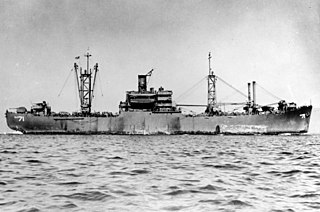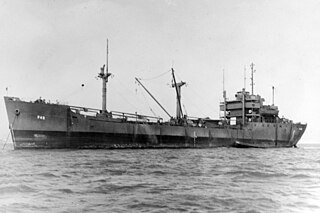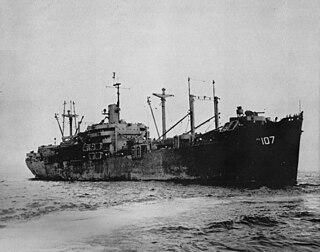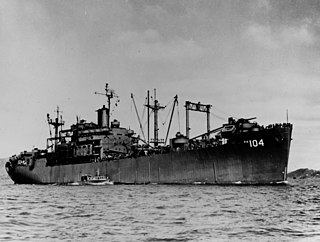USS Leonis (AK-128) was a Crater-class cargo ship in service with the US Navy in World War II. It was the only ship of the Navy to have borne this name, Latin for "of a lion", presumably referring to the northern constellation Leo.

The USS Alnitah (AK-127) was a Crater-class cargo ship in the service of the US Navy in World War II. Named a spelling variation of the star Alnitak in the constellation Orion, it was the only ship of the Navy to bear this name.

USS Todd (AKA-71) was a Tolland-class attack cargo ship in service with the United States Navy from 1944 to 1946. She was sold into commercial service and was scrapped in 1972.

USS Wildcat (AW-2), was a Stag-class tanker, built for the United States Navy during World War II, the only U.S. Naval vessel to be named for Felis silvestris.

USS Kermit Roosevelt (ARG-16) was a Luzon-class internal combustion engine repair ship that saw service in the United States Navy during World War II. She was the only U.S. Naval vessel to be named for Kermit Roosevelt I, the second son of President Theodore Roosevelt and a soldier who served in two world wars.

USS Oceanus (ARB-2) was planned as a United States Navy LST-1-class tank landing ship, but was redesignated as one of twelve Aristaeus-class battle damage repair ships built for the United States Navy during World War II. Named for Oceanus, she was the only US Naval vessel to bear the name.

USS Broadwater (APA-139) was a Haskell-class attack transport in service with the United States Navy from 1945 to 1946. She was scrapped in 1974.

USS Lloyd E. Acree (DE-356) was a John C. Butler-class destroyer escort acquired by the U.S. Navy during World War II. The primary purpose of the destroyer escort was to escort and protect ships in convoy, in addition to other tasks as assigned, such as patrol or radar picket.
USS ATA-176 was an ATR-1-class rescue tug built for the United States Navy during World War II. She was laid down on 30 January 1944 and launched on 1 March as USS ATR-103, but was re-designated ATA-176 on 15 May. She was commissioned as USS ATA-176 on 19 August. She served in the U.S. Pacific Fleet during the war and was decommissioned on 30 June 1947. She was then manned with a civilian crew and placed in service, being renamed USNS Tonkawa (T-ATA-176) on 16 July 1948. Tonkawa, the first U.S. Navy vessel named for the Tonkawa, was taken out of service in 1956 and placed in reserve.

USS Beaverhead (AK-161) was an Alamosa-class cargo ship commissioned by the U.S. Navy for service in World War II. She was responsible for delivering troops, goods and equipment to locations in the war zone.

USS Octavia (AF-46) was an Adria-class stores ship in service with the United States Navy from 1945 to 1946. She was sold into commercial service in 1972 and was scrapped in 2006.

USS Oxford (APA-189) was a Haskell-class attack transport acquired by the U.S. Navy during World War II for the task of transporting troops to and from combat areas.

USS Goodhue (APA-107) was a Bayfield-class attack transport in service with the United States Navy from 1944 to 1946. She was sold into commercial service in 1947 and was scrapped in 1982.

USS Westmoreland (APA-104) was a Bayfield-class attack transport in service with the United States Navy from 1945 to 1946. In 1947, she was sold into commercial service and was scrapped in 1973.

USS Mendocino (APA-100) was a Bayfield-class attack transport that served in the United States Navy from 1944 to 1946. In 1947, she was sold into commercial service and was scrapped in 1973.

USS San Saba (APA-232) was a Haskell-class attack transport which served with the US Navy in World War II. Commissioned in December 1944, she arrived just too late to see action, and spent the last weeks of the war on transport missions.

USS Silverbell (AN-51/YN-70) was an Ailanthus-class net laying ship which served with the U.S. Navy in the South Pacific Ocean theatre of operations during World War II. Her career was without major incident, and she returned home after the war bearing one battle star to her credit.

USS League Island (AG-149/AKS-30) – also known as USS LST-1097 - was an LST-511-class tank landing ship launched by the U.S. Navy during the final months of World War II. League Island served as a supply and stores-issue ship for the U.S. 7th Fleet, and was decommissioned after the war.

USS Palmyra (ARST-3) was a Laysan Island-class salvage craft tender of the United States Navy.

USS Okala (ARST-2) was a Laysan Island-class salvage craft tender of the United States Navy.

















